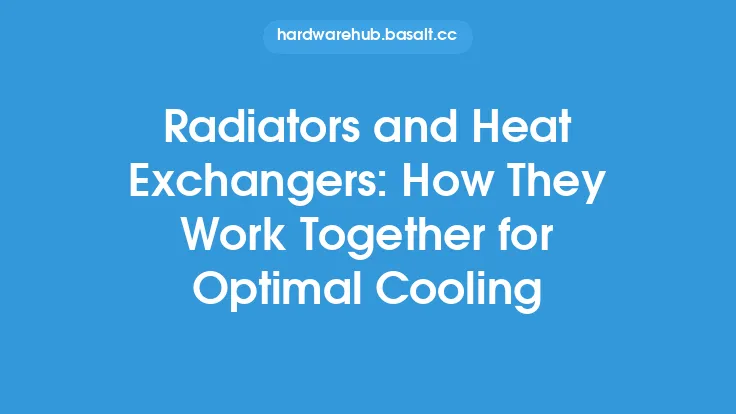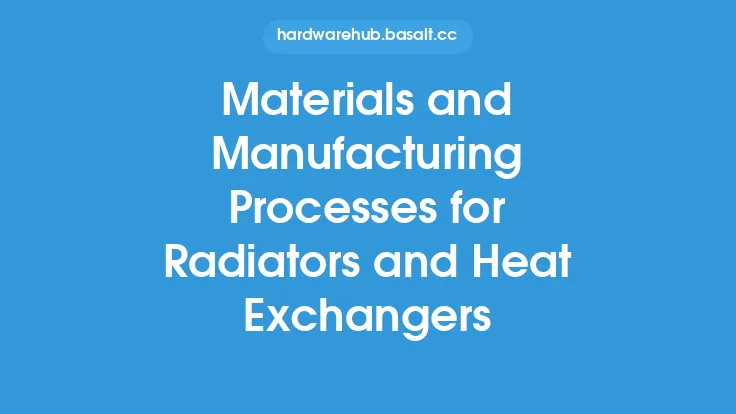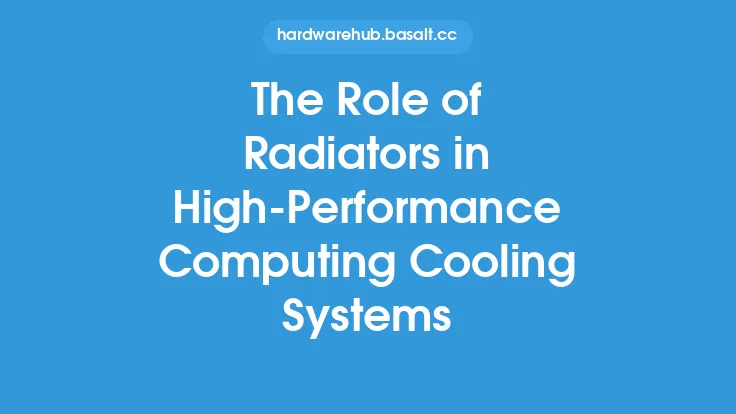When designing compact systems, one of the most critical components to consider is the radiator and heat exchanger. These components play a crucial role in dissipating heat generated by the system, ensuring optimal performance, reliability, and longevity. In compact systems, where space is limited, the design of radiators and heat exchangers requires careful consideration to achieve efficient heat transfer, minimize pressure drop, and reduce noise levels.
Introduction to Compact System Cooling
Compact systems, such as those used in aerospace, automotive, and industrial applications, pose unique challenges when it comes to cooling. The limited space available in these systems requires innovative solutions to dissipate heat effectively. Radiators and heat exchangers are essential components in these systems, and their design must be carefully optimized to meet the specific cooling requirements of the application. The goal is to achieve a balance between heat transfer, pressure drop, and noise levels, while also ensuring reliability, durability, and maintainability.
Design Parameters for Radiators and Heat Exchangers
Several design parameters must be considered when designing radiators and heat exchangers for compact systems. These include:
- Heat transfer coefficient: This parameter determines the rate at which heat is transferred from the fluid to the surrounding environment. A higher heat transfer coefficient indicates more efficient heat transfer.
- Pressure drop: This parameter affects the energy required to pump fluid through the system. A lower pressure drop reduces the energy consumption and noise levels.
- Fluid flow rate: This parameter determines the amount of fluid that flows through the system, which in turn affects the heat transfer rate.
- Temperature difference: This parameter determines the driving force for heat transfer. A larger temperature difference between the fluid and the surrounding environment increases the heat transfer rate.
- Material properties: The properties of the materials used to construct the radiator and heat exchanger, such as thermal conductivity, density, and corrosion resistance, can significantly impact the performance of the system.
Heat Exchanger Configurations
Heat exchangers can be configured in various ways to achieve optimal performance in compact systems. Some common configurations include:
- Plate-fin heat exchangers: These heat exchangers consist of a series of plates and fins that are stacked together to form a compact unit. They offer high heat transfer rates and are commonly used in aerospace and automotive applications.
- Tube-fin heat exchangers: These heat exchangers consist of a series of tubes that are surrounded by fins. They offer a high surface area-to-volume ratio and are commonly used in industrial applications.
- Plate heat exchangers: These heat exchangers consist of a series of plates that are stacked together to form a compact unit. They offer high heat transfer rates and are commonly used in industrial applications.
Radiator Design Considerations
Radiators play a critical role in dissipating heat generated by the system. When designing radiators for compact systems, several factors must be considered, including:
- Core design: The core design of the radiator determines the heat transfer rate and pressure drop. A well-designed core can minimize pressure drop while maximizing heat transfer.
- Fin design: The fin design of the radiator determines the heat transfer rate and can significantly impact the overall performance of the system.
- Tube design: The tube design of the radiator determines the fluid flow rate and pressure drop. A well-designed tube can minimize pressure drop while maximizing fluid flow rate.
- Material selection: The materials used to construct the radiator can significantly impact the performance of the system. Materials with high thermal conductivity, such as copper or aluminum, are commonly used in radiator construction.
Compact System Cooling Challenges
Compact systems pose unique challenges when it comes to cooling. Some of the challenges include:
- Limited space: The limited space available in compact systems requires innovative solutions to dissipate heat effectively.
- High heat flux: Compact systems often generate high heat fluxes, which can be challenging to dissipate using traditional cooling methods.
- Noise reduction: Compact systems often require low noise levels, which can be challenging to achieve using traditional cooling methods.
- Reliability and durability: Compact systems often require high reliability and durability, which can be challenging to achieve using traditional cooling methods.
Future Directions
The design of radiators and heat exchangers for compact systems is a rapidly evolving field, with new technologies and materials being developed to address the unique challenges posed by these systems. Some future directions include:
- Advanced materials: New materials with high thermal conductivity, such as nanomaterials and advanced composites, are being developed to improve the performance of radiators and heat exchangers.
- Additive manufacturing: Additive manufacturing techniques, such as 3D printing, are being used to create complex geometries and structures that can improve the performance of radiators and heat exchangers.
- Hybrid cooling systems: Hybrid cooling systems that combine multiple cooling methods, such as air and liquid cooling, are being developed to achieve optimal performance in compact systems.
Conclusion
The design of radiators and heat exchangers for compact systems requires careful consideration of several factors, including heat transfer, pressure drop, fluid flow rate, temperature difference, and material properties. By understanding these factors and using innovative design techniques, such as advanced materials and additive manufacturing, it is possible to create compact cooling systems that achieve optimal performance, reliability, and durability. As the field continues to evolve, new technologies and materials will be developed to address the unique challenges posed by compact systems, enabling the creation of even more efficient and effective cooling solutions.





